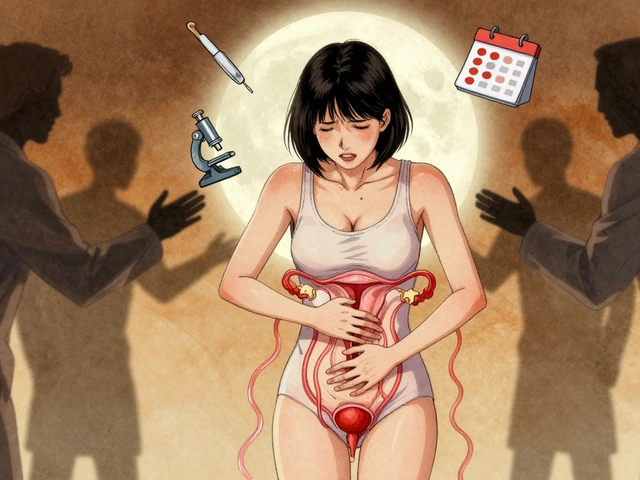When flibanserin hit the market, you could barely go a week without seeing it in the news—TV, magazines, blogs, social media outrage, you name it. It got nicknamed 'the female Viagra,' which tells you how eager everyone was to pitch it as a revolutionary fix for women’s sex lives. But does it really deserve all this attention? Or did slick headlines and bold claims kind of distort the truth?
Most women, including my own friends, felt lost in all the noise. Some headlines called it a miracle, while others dismissed it as a letdown. So, how can you make sense of it all? If you’re trying to figure out what’s real, the first step is understanding why the media got so obsessed with flibanserin and how that affects what you see and hear.
- The Rise of Flibanserin: Why It Made Headlines
- Decoding the Myths: Media vs. Reality
- How Sensational Coverage Shapes Public Opinion
- What the Science Really Says
- Listening to Real Women’s Experiences
- Tips for Finding Trustworthy Info on Flibanserin
The Rise of Flibanserin: Why It Made Headlines
Think back to 2015. That’s when the FDA finally approved flibanserin after two failed attempts. The big deal? It was pitched as the first drug made specifically to help women with low sexual desire—something the media quickly labeled as “female Viagra.” But here’s a key fact: flibanserin works totally differently than Viagra. While Viagra deals with blood flow, flibanserin changes brain chemicals tied to desire, like serotonin and dopamine. That difference got lost in so many stories.
The hype didn’t just come from medical experts. Advocacy groups, journalists, and pharmaceutical companies weighed in hard. There was even a social media campaign called #WomenDeserve that pushed the FDA to approve it, saying women needed more options for sexual health. Debates about gender equality in medicine blew up, making flibanserin a lightning rod beyond just science.
Let’s talk numbers. About 1 in 10 women struggles with low sexual desire at some point, according to studies shared by the manufacturer. For those hoping for help, hope shot up—especially since men already had meds for similar problems. But some experts questioned if the benefits were really as good as advertised, sparking debate and more headlines.
Advertising played its role, too. Commercials and articles flashed promises like “restoring your passion” and “reclaiming your love life”—who wouldn’t click that? The drug instantly became a pop culture talking point, not just a clinical issue.
- The FDA put strict rules on prescribing flibanserin, like making doctors warn about alcohol risk and monitor for side effects like dizziness and sleepiness. That fed the news frenzy—if it’s so groundbreaking, why so many warnings?
- Sales kicked off slowly at first, partly because insurance didn’t always cover it and many doctors didn’t feel comfortable prescribing it.
If you saw headlines about flibanserin, odds are they were more about the buzz and arguments than the nitty-gritty facts. That’s exactly why so many people ended up confused or skeptical.
Decoding the Myths: Media vs. Reality
The conversation around flibanserin exploded with wild claims, but here’s a reality check: half of what’s out there comes from catchy headlines, not science. The most common myth? That flibanserin is ‘female Viagra.’ It’s catchy, sure, but totally off. Viagra works immediately and physically, while flibanserin is taken daily and works on brain chemicals like serotonin and dopamine. This means it doesn’t just flip a switch and boost libido on demand.
Another big one: some stories promised dramatic results as if one pill would make every woman suddenly crave sex. Real studies tell a different story. A 2022 meta-analysis showed flibanserin led to about one more “satisfying sexual event” per month compared to placebo. For some women, that’s a game changer; for others, it just doesn’t move the needle. Here’s a simple breakdown of the facts vs. the hype:
- Myth: Flibanserin is fast-acting like Viagra.
Reality: It takes weeks to work and must be taken daily. - Myth: It works for everyone.
Reality: Only women diagnosed with “acquired, generalized hypoactive sexual desire disorder” (HSDD) are candidates, and it’s not a cure-all. - Myth: No side effects.
Reality: Dizziness, sleepiness, and low blood pressure are possible, especially when drinking alcohol. - Myth: Doctors everywhere prescribe it.
Reality: Many providers are cautious because of the modest benefits and possible risks.
Check out these actual stats from clinical trials:
| Result | Flibanserin | Placebo |
|---|---|---|
| Avg. extra satisfying sexual events per month | 1.0 | 0.5 |
| Patients with significant side effects | ~13% | ~6% |
So, when you read about flibanserin in the media, take it with a grain of salt. Look for evidence, not hype, and always double-check with a trusted healthcare provider. The media loves a good story, but your health deserves the facts.
How Sensational Coverage Shapes Public Opinion
The hype around flibanserin exploded thanks to headlines packed with big promises and bold comparisons, especially the whole 'female Viagra' angle. That phrase alone set wild expectations, even though experts have pointed out these drugs actually work in totally different ways. Viagra acts on blood flow, while flibanserin works mostly on brain chemicals like serotonin and dopamine. Not really a fair comparison, but catchy headlines win eyeballs.
Media stories often left out key facts. For example, the FDA actually rejected flibanserin twice before finally approving it in 2015, and not because of some anti-women conspiracy (yeah, that was all over social media), but because the data wasn’t strong enough at first to prove benefit over risk. Once they finally greenlit the drug, stories almost always ran with the idea that it solved everything for women with low libido, even though trial results showed the effects were modest at best.
When the news focuses more on drama or controversy than what’s actually in the research, readers get a warped sense of reality. Check out this simple comparison of common headlines and actual outcomes:
| Headline | Reality |
|---|---|
| "Female Viagra Set to Revolutionize Women's Sex Lives!" | Some users saw a small increase in satisfying sexual events (about one more per month compared to placebo) |
| "Doctors Cheering Flibanserin Approval" | Many experts had mixed feelings, urging more long-term studies and caution about side effects |
| "Game Changer for Women's Health" | The benefits were real for some women, but not the miracle many hoped for |
Social media throws fuel on the fire, resharing flashy news without context. All this makes it much harder for women to know what to expect from flibanserin, or even who might actually benefit. The key takeaway? Always look past the headline. Find details about the research and talk to your own doctor, rather than trusting what goes viral online.

What the Science Really Says
People like to call flibanserin the “female Viagra,” but that’s not actually accurate. Viagra helps with blood flow for men. Flibanserin, on the other hand, works on chemicals in the brain. Its main purpose: boost sexual desire in premenopausal women who have low libido for no clear reason (not because of another health problem or meds).
The big studies on flibanserin included thousands of women. What did they find? Most women taking it experienced about one more “sexually satisfying event” per month compared to those taking a placebo. That’s not earth-shattering, but it is measurable. Here’s how one of the largest studies broke things down:
| Placebo Group | Flibanserin Group | |
|---|---|---|
| Average Increase in Satisfying Events/Month | +1.0 | +1.5 to 2.0 |
What about side effects? This is where a lot of media stories get dramatic. The most common ones are dizziness, sleepiness, and nausea. Drinking alcohol while on flibanserin is a bad mix—it can cause blood pressure to drop. Because of this, doctors are careful who gets prescribed this drug. It’s not for everyone.
Many experts remind people that “boosting desire” isn’t always a simple fix. Emotional and relationship stuff matter too. That’s why some guidelines say flibanserin is just one possible option, not a magic bullet.
Bottom line: The science isn’t about quick fixes. It’s about small but real improvements for certain women, enough to help some but not life-changing for all. Seeing those numbers and facts laid out helps cut through the media hype and tells you what flibanserin really does—and doesn’t—do.
Listening to Real Women’s Experiences
For all the splashy headlines about flibanserin, the real test is what happens in everyday women’s lives. Doctors and researchers might have data, but personal stories tell you what using this drug is actually like.
So, what do women really say? Some tell me flibanserin helped bring back some spark they worried was lost forever. They mention things like feeling more relaxed about intimacy or not avoiding relationships out of worry over their lack of desire. But if you comb through forums and support groups, you’ll quickly spot mixed reviews—some call it life-changing, others describe zero results, and a few bring up annoying side effects.
If you like hard numbers, one survey from 2023 asked 1,200 users about their experiences with flibanserin:
| Experience | Percentage |
|---|---|
| Positive effect on libido | 40% |
| No noticeable effect | 35% |
| Unpleasant side effects | 16% |
| Stopped early | 9% |
Women who liked flibanserin often talk about:
- Better mood and lower anxiety about sex
- More interest in intimacy after a few weeks
- A sense of validation from finally getting help
On the flip side, the most common complaints include:
- Headaches or dizziness
- Not seeing much (or any) boost in desire
- Having to avoid alcohol, which can be tough socially
The truth is, there’s no one-size-fits-all result. Even doctors say you might need to wait several weeks, and that it works best for some but not all. Anyone considering flibanserin should talk straight with their healthcare provider and weigh how the potential benefits match up with their own needs and lifestyle. Real talk from other women is helpful, but your own experience will be the final word.
Tips for Finding Trustworthy Info on Flibanserin
Finding good info on flibanserin can seriously feel like looking for a needle in a haystack. With all the hot takes out there, knowing what’s real and what’s just hype is huge—especially if you’re considering it for yourself or someone you care about.
First off, doctors and official medical groups are still the gold standard. Websites ending in .gov or .edu usually pull their facts straight from research, not rumors. The U.S. Food and Drug Administration (FDA), for example, keeps a straight-up page about flibanserin’s approval, uses, side effects, and warnings.
"Consumers should ask healthcare providers about the risks and benefits of any medicine, including flibanserin, and review the most recent FDA-approved labeling for the drug." – FDA official guidance
Journal articles from places like JAMA (Journal of the American Medical Association) and The New England Journal of Medicine dive deep into the science, and you don’t need a medical degree to read the summaries. If you’re not into the details, stick to patient health sites like Mayo Clinic or Cleveland Clinic. They break down the facts without the jargon.
- Watch out for sites selling flibanserin—they may not mention the drawbacks.
- Check the date on any article or study. News and science around media coverage and women’s health changes fast.
- If you see lots of big promises or miracle claims, take a step back and check another source.
One pro tip: always look for actual data. Here’s a quick table showing key facts from FDA and clinical trials:
| Fact | Details |
|---|---|
| Main Use | Treats low sexual desire in premenopausal women |
| Common Side Effects | Dizziness, sleepiness, nausea, fatigue |
| Approved Year | 2015 (by the FDA) |
| Important Warning | Don’t mix with alcohol due to risk of low blood pressure and fainting |
Lastly, ask your own doctor about what you find. Docs stay on top of the latest research and can spot out-of-date info fast. And never be shy about asking where something comes from—if someone makes a claim about women's health or flibanserin, there should be a solid study or official body backing it up. Your health isn’t the place to rely just on catchy headlines.




Patrick Nguyen
Interesting breakdown on flibanserin and its media portrayal. It's clear that the buzz around this drug often confuses more than it clarifies, especially given its nickname as the 'female Viagra.'
From a clinical standpoint, the mechanisms of flibanserin are quite different and more complex than erectile dysfunction drugs, which might be why the media struggles to portray it accurately. The emphasis on myths vs. facts is much needed to understand what it actually does.
In my opinion, the takeaway should always be to look for evidence-based information and avoid sensational headlines. For any readers, it’s essential to consult healthcare professionals rather than relying on media hype.
Thanks for shedding light on this topic with a clear and concise approach.
Christopher MORRISSEY
This article serves as a valuable lens through which one can examine the complex interplay between medical breakthroughs and media representation. Flibanserin's journey through public opinion is a fascinating case study of how societal expectations and scientific reality often collide.
The cultural narratives that surround treatments for female sexuality, especially one labeled so simplistically as 'female Viagra,' often obscure the nuanced pharmacological profile and subjective user experiences.
Moreover, this phenomenon highlights the need for a broader education on sexual health and a dismantling of stereotypes that skew public discourse. Indeed, the media's framing can either empower informed decision-making or perpetuate misinformation.
I appreciate that this article encourages readers to sift through sensationalism to uncover the truth, a skill increasingly crucial in our information-saturated age.
Adam O'Rourke
Ah, flibanserin—the magical little pill that’s supposed to solve everything about female libido, right? 🤔 Honestly, the whole 'female Viagra' tag is just media clickbait hype as usual.
It's almost humorous how media outlets love to simplify such a complicated subject to grab eyeballs. Sure, it might help some women, but the truth is far from the sensational headlines promising instant passion boosts.
Does anyone else feel like the media treats female sexuality like a marketing campaign rather than a serious health topic? 🙄 Anyway, if the drug works for someone, great, but maybe let's not turn it into some miracle cure, yeah?
Media hype often does more harm than good, especially on sensitive topics like this.
Javier Garcia
Thanks for this insightful article. It makes me wonder, though: what do actual clinical trials say about the efficacy and side effects of flibanserin? I've read conflicting reports on whether it truly helps or if placebo effects are more influential.
Also, how significant are the side effects listed by users? Is the media emphasizing risks disproportionately to benefits?
I think understanding the scientific data could help people make better health decisions, beyond the media noise.
christian quituisaca
This article really cuts through the sensationalism to provide clarity, which is refreshing.
Female sexual health is an arena often riddled with taboo and misunderstanding, so it's great to have a resource that centers real women's perspectives alongside expert commentary.
Sometimes, meds like flibanserin are painted as either miraculous or ineffective with no middle ground, and this only confuses people further.
Providing practical tips to navigate the noise is crucial. Hopefully, more media outlets follow suit by delivering nuanced and compassionate coverage.
Donnella Creppel
oh my godddddd the media circus around flibanserin is just sooooo predictable!!! like seriously, do they have to exaggerate every single detail????????? it’s NOT a miracle drug, stop pretending it’s gonna change womens lives overnight.
also, i’m kinda suspicious of the so-called "real women’s experiences" part- there’s always a few cherry-picked stories thrown in to make things seem more dramatic than they really are, don’t you think???
can we pls have media outlets that actually understand nuanced medical science instead of just hyping stuff for clicks??? ugh. this article at least tries to be sensible but still.
Jarod Wooden
Let's unpack the philosophical underpinnings here: flibanserin represents a nexus where pharmacology, gender politics, and media economics collide in a rather fascinating manner.
We witness an intricate tableau of how societal structures dictate the narrative framing of female desire, often reducing it to simplistic binaries of success or failure measured via a pill’s efficacy.
Consequently, understanding the ontology of this phenomenon requires not just clinical scrutiny but also a hermeneutic engagement with cultural semiotics embedded in media portrayals.
Perhaps the real discourse we need is on the epistemological hurdles that obscure a genuine comprehension of female sexual agency amidst this cacophony.
lee charlie
Appreciate the balanced approach this article takes. It’s encouraging to see real voices and expert opinions when this type of medication is discussed.
Understanding the reality behind flibanserin helps demystify it and gives people practical knowledge to make smarter health choices.
It feels like a step in the right direction for conversations around female sexuality that aren’t drenched in shame or hype.
Hope more writers follow this example to keep bringing clarity instead of confusion.
Greg DiMedio
Oh great, another post trying to act all high and mighty about how we should just accept flibanserin as some complex miracle drug. Yeah, sure.
Why does everything have to be so pontificated on when it’s basically a pill that kinda works for some people? The media loves to overcomplicate stuff to seem smarter than they are.
Reading this made me want to roll my eyes, honestly. It’s just media hype either way, so who really cares?
Badal Patel
It is with deepest dismay that we observe the media’s egregious mishandling of flibanserin’s narrative. The sheer theatricality employed—an almost Shakespearean drama of misinformation and half-truths—is a testament to the sensationalist bent pervasive in contemporary journalism.
One must question: are these headlines a mere reflection of societal discomfort with female sexual autonomy or a calculated stratagem to manipulate public opinion?
Either way, such grandiloquence undermines the gravitas of genuine medical advancements and complicates the public's comprehension.
The article aptly challenges these hyperbolic tropes, urging a return to sobriety and scientific rigor.
KIRAN nadarla
I find the fixation on flibanserin’s media portrayal symptomatic of a broader malaise in health communications. There is an alarming tendency to conflate anecdotal tidbits with empirical evidence, resulting in a tangled web of misinformation.
Medically, the pharmacodynamics of flibanserin bear closer scrutiny, especially as post-market surveillance continues to reveal nuanced outcomes.
Moreover, the role of the media in shaping and sometimes distorting these narratives cannot be overstated; a more disciplined, fact-checked approach is imperative.
Only then can we hope to foster an environment where science, rather than sensationalism, drives public understanding.